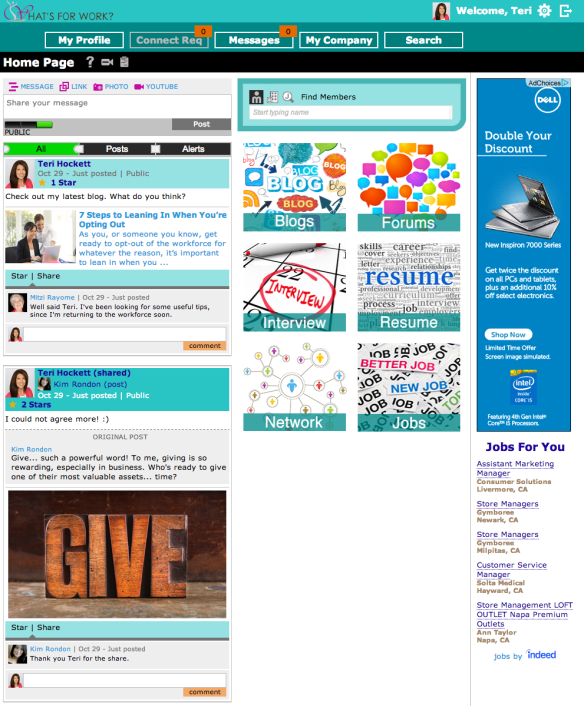A new website is now available that empowers women to take control of their career, whether they are employed or not, while bridging the gap between personal and professional relationships via social media engagement.
Danville, CA (PRWEB) November 4, 2013 – What’s For Work? (www.whatsforwork.com) The Premier Site for Empowered Women, has released a new version of their website. New features include: social streaming (messages, comments, stars, links, photos, video, and introductions), profiles, blogs, forums, job search, resume builder, interview worksheets, and more.
What’s For Work? has bridged the gap in the world of Career Management by providing a unique community where women help each other; whether they are looking for work, already employed, or Employed By Life. The new website allows women to build personal and professional relationships with members and companies using social technology; while allowing them to showcase their skills and expertise that builds their personal brand and online social presence. Social streaming capabilities allow members to share messages, links, photos and videos, star content of interest, introduce people, comment and share.
Teri Hockett, CEO of What’s For Work? said, “We realized our community desperately needed a place where members could express themselves on a personal and professional level, so we took action to create that unique space for them.”
From the moment members logon to the new website, they can quickly Learn, Share, and Engage with members and companies alike. If they are looking for work, they can build their resume, search and apply for jobs, and prepare for interviews using tools that guide them through the process. Companies are automatically notified when someone applies for job postings, and can manage the application process from A-Z; which provides automatic notifications to the applicant of the status. In short, the resume-black-hole-problem of the Internet is solved.
For those already employed, What’s For Work? provides a great platform to build and/or expand one’s personal brand. Members can mentor others, and take advantage of blogging to build their online presence and showcase their expertise. Blogging is quick and easy, and viewable to people inside and/or outside of the community.
For Moms returning to the workforce that have been Employed by Life, What’s For Work? teaches them how to create their next job opportunity by tapping into the hidden job market. Kim Rondon said, “I have spent months on countless job search engines watching my resume go into an abyss. Recently, I was introduced to whatsforwork.com. Registering was quick and easy. After going through the site and all it has to offer, from the resume builder to the forums, video tutorials, and my own place to blog, whatsforwork.com is a perfect fit for me – a mother of two who is going back into the workforce after a dozen years. I am looking forward to a continued relationship with this company and its community. I highly recommend it to every woman looking not just for a job, but a career, and beyond.”
For companies, the new website is just as powerful. It provides them with a rich and diverse talent pool of highly skilled women. Debra Constantine said, “I am so excited. On my first full day as an Employer on What’s For Work?, I sent 3 messages out around 4:00 pm, and heard from two great candidates within 30 minutes! Can’t tell you how thrilled I am with the response.”
This new website represents a significant shift in Career Management for Women; the game has changed.
About What’s For Work?
What’s For Work? (www.whatsforwork.com) The Premier Site for Empowered Women, is a unique career focused community that helps women find the work they love by providing a rich set of tools and resources to locate jobs, build a resume, prepare for interviews, explore the hidden job market, blog, connect with other women, network with experts, and more; giving them the knowledge, skills, and confidence needed to be successful.










